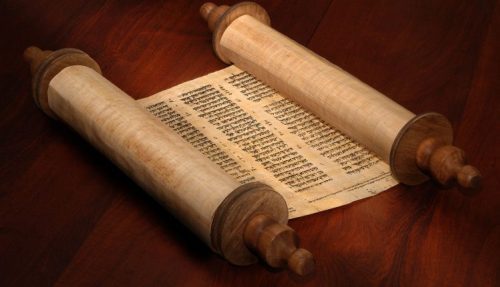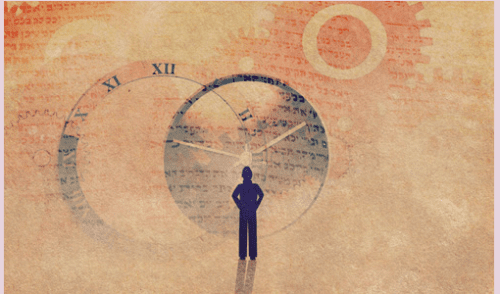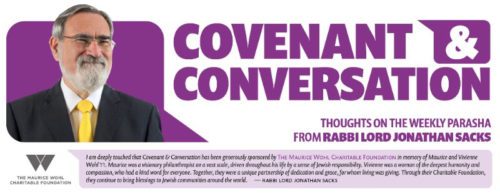

It is a moment of the very highest drama. The Israelites, a mere forty days after the greatest revelation in history, have made an idol: a Golden Calf. God threatens to destroy them. Moses, exemplifying to the fullest degree the character of Israel as one who “wrestles with God and man,” confronts both in turn. To God, he prays for mercy for the people. Coming down the mountain and facing Israel, he smashes the tablets, symbol of the covenant. He grinds the calf to dust, mixes it with water, and makes the Israelites drink it. He commands the Levites to punish the wrongdoers. Then he re-ascends the mountain in a prolonged attempt to repair the shattered relationship between God and the people.
God accepts his request and tells Moses to carve two new tablets of stone. At this point, however, Moses makes a strange appeal:
And Moses hurried and knelt to the ground and bowed, and he said, “If I have found favour in Your eyes, my Lord, may my Lord go among us, because [ki] it is a stiff-necked people, and forgive our wickedness and our sin, and take us as Your inheritance.” (Ex. 34:8–9)
The difficulty in the verse is self-evident. Moses cites as a reason for God remaining with the Israelites the very attribute that God had previously given for wishing to abandon them:
“I have seen these people,” the Lord said to Moses, “and they are a stiff-necked people. Now leave Me alone so that My anger may burn against them and that I may destroy them. Then I will make you into a great nation.” (Ex. 32:9)
How can Moses invoke the people’s obstinacy as the very reason for God to maintain His presence among them? What is the meaning of Moses’ “because” – “may my Lord go among us, because it is a stiff- necked people”?
The commentators o?er a variety of interpretations. Rashi reads the word ki as “if ” – “If they are stiff-necked, then forgive them.”[1] Ibn Ezra[2] and Chizkuni[3] read it as “although” or “despite the fact that” (af al pi). Alternatively, suggests Ibn Ezra, the verse might be read, “[I admit that] it is a stiff-necked people – therefore forgive our wickedness and our sin, and take us as Your inheritance.”[4] These are straightforward readings, though they assign to the word ki a meaning it does not normally have.
There is, however, another and far more striking line of interpretation that can be traced across the centuries. In the twentieth century it was given expression by Rabbi Yitzchak Nissenbaum. The argument he attributed to Moses was this:
Almighty God, look upon this people with favour, because what is now their greatest vice will one day be their most heroic virtue. They are indeed an obstinate people…But just as now they are stiff- necked in their disobedience, so one day they will be equally stiff-necked in their loyalty. Nations will call on them to assimilate, but they will refuse. Mightier religions will urge them to convert, but they will resist. They will suffer humiliation, persecution, even torture and death because of the name they bear and the faith they profess, but they will stay true to the covenant their ancestors made with You. They will go to their deaths saying Ani ma’amin, “I believe.” This is a people awesome in its obstinacy – and though now it is their failing, there will be times far into the future when it will be their noblest strength.[5]
The fact that Rabbi Nissenbaum lived and died in the Warsaw ghetto gives added poignancy to his words.[6]
Many centuries earlier, a Midrash made essentially the same point:
There are three things which are undaunted: the dog among beasts, the rooster among birds, and Israel among the nations. R. Isaac ben Redifa said in the name of R. Ami: You might think that this is a negative attribute, but in fact it is praiseworthy, for it means: “Either be a Jew or prepare to be hanged.”[7]
Jews were stiff-necked, says Rabbi Ami, in the sense that they were ready to die for their faith. As Gersonides (Ralbag) explained in the fourteenth century, a stubborn people may be slow to acquire a faith, but once they have done so they never relinquish it.[8]
We catch a glimpse of this extraordinary obstinacy in an episode narrated by Josephus, one of the first recorded incidents of mass non-violent civil disobedience. It took place during the reign of the Roman emperor Caligula (37–41 CE). He had proposed placing a statue of himself in the precincts of the Temple in Jerusalem, and had sent the military leader Petronius to carry out the task, if necessary by force. This is how Josephus describes the encounter between Petronius and the Jewish population at Ptolemais (Acre):
There came ten thousand Jews to Petronius at Ptolemais to offer their petitions to him that he would not compel them to violate the law of their forefathers. “But if,” they said, “you are wholly resolved to bring the statue and install it, then you must first kill us, and then do what you have resolved on. For while we are alive we cannot permit such things as are forbidden by our law…”
Then Petronius came to them (at Tiberius): “Will you then make war with Caesar, regardless of his great preparations for war and your own weakness?” They replied, “We will not by any means make war with Caesar, but we will die before we see our laws transgressed.” Then they threw themselves down on their faces and stretched out their throats and said that they were ready to be slain…Thus they continued firm in their resolution and proposed themselves to die willingly rather than see the statue dedicated.”[9]
Faced with such heroic defiance on so large a scale, Petronius gave way and wrote to Caligula urging him, in Josephus’ words, “not to drive so many ten thousand of these men to distraction; that if he were to slay these men, he would be publicly cursed for all future ages.”
Nor was this a unique episode. The rabbinic literature, together with the chronicles of the Middle Ages, are full of stories of martyrdom, of Jews willing to die rather than convert. Indeed the very concept of Kiddush Hashem, sanctification of God’s name, came to be associated in the halachic literature with the willingness “to die rather than transgress.” The rabbinic conclave at Lod (Lydda) in the second century CE, which laid down the laws of martyrdom (including the three sins about which it was said that “one must die rather than transgress”)[10] may have been an attempt to limit, rather than encourage, the phenomenon. Of these many episodes, one stands out for its theological audacity. It was recorded by the Jewish historian Shlomo ibn Verga (fifteenth to sixteenth centuries) and concerns the Spanish expulsion:
One of the boats was infested with the plague, and the captain of the boat put the passengers ashore at some uninhabited place…There was one Jew among them who struggled on afoot together with his wife and two children. The wife grew faint and died… The husband carried his children along until both he and they fainted from hunger. When he regained consciousness, he found that his two children had died.
In great grief he rose to his feet and said: “O Lord of all the universe, You are doing a great deal that I might even desert my faith. But know You of a certainty that – even against the will of heaven – a Jew I am and a Jew I shall remain. And neither that which You have brought upon me nor that which You may yet bring upon me will be of any avail.”[11]
One is awestruck by such faith – such obstinate faith. Almost certainly it was this idea that lies behind a famous Talmudic passage about the giving of the Torah at Mount Sinai:
And they stood under the mountain: R. Avdimi b. Chama b. Chasa said: This teaches that the Holy One blessed be He, overturned the mountain above them like a barrel and said, “If you accept the Torah, it will be well. If not, this will be your burial place.” Said Rava, Even so, they re-accepted the Torah in the days of Ahasuerus, for it is written, “the Jews confirmed and took upon them”, meaning, “they confirmed what they had accepted before.”[12]
The meaning of this strange text seems to be this: at Sinai the Jewish people had no choice but to accept the covenant. They had just been rescued from Egypt. God had divided the sea for them; He had sent them manna from heaven and water from the rock. Acceptance of a covenant under such conditions cannot be called free. The real test of faith came when God was hidden. Rava’s quotation from the Book of Esther is pointed and precise. Megillat Esther does not contain the name of God. The rabbis suggested that the name Esther is an allusion to the phrase haster astir et panai, “I will surely hide My face.” The book relates the first warrant for genocide against the Jewish people. That Jews remained Jews under such conditions was proof positive that they did indeed reaffirm the covenant. Obstinate in their disbelief during much of the biblical era, they became obstinate in their belief ever afterwards. Faced with God’s presence, they disobeyed Him. Confronted with His absence, they stayed faithful to Him. That is the paradox of the stiff-necked people.
Not by accident does the main narrative of the Book of Esther begin with the words “And Mordechai would not bow down” (Esther 3:1). His refusal to make obeisance to Haman sets the story in motion. Mordechai too is obstinate – for there is one thing that is hard to do if you have a stiff neck, namely, bow down. At times, Jews found it hard to bow down to God – but they were certainly never willing to bow down to anything less. That is why, alone of all the many peoples who have entered the arena of history, Jews – even in exile, dispersed, and everywhere a minority – neither assimilated to the dominant culture nor converted to the majority faith.
“Forgive them because they are a stiff-necked people,” said Moses, because the time will come when that stubbornness will be not a tragic failing but a noble and defiant loyalty. And so it came to be.
Shabbat shalom,

[1] Rashi, commentary to Exodus 34:9.
[2] In his “short” commentary to Exodus 34:9. In his long commentary he quotes this view in the name of R. Yonah ibn Yanah (R. Marinus, 990–1050).
[3] Hezekiah ben Manoah, a French rabbi and exegete who lived during the thirteenth century.
[4] Ibn Ezra, “long” commentary ad loc.
[5] This is my paraphrase of the commentary cited in the name of R. Yitzhak Nissenbaum in Aaron Yaakov Greenberg, ed., Itturei Torah, Shemot (Tel Aviv, 1976), 269–70.
[6] For R. Nissenbaum’s remarkable speech in the Warsaw Ghetto, see Emil Fackenheim, To Mend the World (New York: Schocken, 1982), 223.
[7] Beitza 25b; Shemot Rabbah 42:9.
[8] Ralbag, commentary to Exodus 34:9.
[9] Josephus Antiquities of the Jews, bk. 18, chap. 8. Cited in Milton Konvitz, “Conscience and Civil Disobedience in the Jewish Tradition,” in Contemporary Jewish Ethics, ed. Menachem Kellner (New York: Sanhedrin Press, 1978), 242–43.
[10] Sanhedrin 74a. The three sins were murder, idolatry and incest. Martyrdom was a complex problem at various points in Jewish history. Jews found themselves torn between two conflicting ideals. On the one hand, self-sacrifice was the highest form of Kiddush Hashem, sanctification of God’s name. On the other, Judaism has a marked preference for life and its preservation.
[11] In Nahum Glatzer, A Jewish Reader (New York: Schocken, 1975), 204–5. It was this passage that inspired Zvi Kolitz’s famous Holocaust fiction about one man’s defiance of God in the name of God, Yossl Rakover Talks to God (New York: Vintage, 2000).
[12] Shabbat 88a. See essay “Mount Sinai and the Birth of Freedom,” p. 149.

An international religious leader, philosopher, award-winning author and respected moral voice, Rabbi Lord Jonathan Sacks was awarded the 2016 Templeton Prize in recognition of his “exceptional contributions to affirming life’s spiritual dimension.” Described by H.R.H. The Prince of Wales as “a light unto this nation” and by former British Prime Minister Tony Blair as “an intellectual giant”, Rabbi Sacks is a frequent and sought-after contributor to radio, television and the press both in Britain and around the world.
Since stepping down as the Chief Rabbi of the United Hebrew Congregations of the Commonwealth – a position he served for 22 years between 1991 and 2013 – Rabbi Sacks has held a number of professorships at several academic institutions including Yeshiva University and King’s College London. In addition to his writing and lecturing, he currently serves as the Ingeborg and Ira Rennert Global Distinguished Professor at New York University. Rabbi Sacks has been awarded 17 honorary doctorates including a Doctor of Divinity conferred to mark his first ten years in office as Chief Rabbi, by the then Archbishop of Canterbury, Lord Carey.
Rabbi Sacks is the author of over 30 books. Among them, Rabbi Sacks has published a new English translation and commentary for the Koren Sacks Siddur, the first new Orthodox siddur in a generation, as well as powerful commentaries for the Rosh HaShana, Yom Kippur, Pesach, Shavuot and Sukkot Machzorim. His most recent work, Not in God’s Name: Confronting Religious Violence was awarded a 2015 National Jewish Book Award in America and was a top ten Sunday Times bestseller in the UK. Past works include: The Great Partnership: God, Science and the Search for Meaning; The Dignity of Difference: How to Avoid the Clash of Civilizations, winner of the Grawemeyer Prize for Religion in 2004 for its success in defining a framework for interfaith dialogue between people of all faith and of none; To Heal a Fractured World: The Ethics of Responsibility; and A Letter in the Scroll: On Being Jewish, winner of a National Jewish Book Awards in 2000. His Covenant & Conversationcommentaries on the weekly Torah portion are read in Jewish communities around the world.
In recognition of his work, Rabbi Sacks has received, among others, the Jerusalem Prize in 1995 for his contribution to diaspora Jewish life, The Ladislaus Laszt Ecumenical and Social Concern Award from Ben Gurion University in Israel in 2011, The Guardian of Zion Award from the Ingeborg Rennert Center for Jerusalem Studies at Bar-Ilan University in 2014, and The Katz Award in recognition of his contribution to the practical analysis and application of Halakha in modern life in Israel in 2014. He was named as The Becket Fund’s 2014 Canterbury Medalist for his role in the defence of religious liberty in the public square; won a Bradley Prize in 2016 in recognition of being “a leading moral voice in today’s world”; and in 2017, he was awarded the Irving Kristol Award from the American Enterprise Institute for his “remarkable contributions to philosophy, religion, and interfaith discourse… as one of the world’s greatest living public intellectuals.” In 2018, he was given the Lifetime Achievement Award by The London Jewish News in recognition of his services to the Jewish world and wider society.
Rabbi Sacks was knighted by Her Majesty The Queen in 2005 and made a Life Peer, taking his seat in the House of Lords in October 2009. Born in 1948 in London, he has been married to Elaine since 1970. They have three children and several grandchildren.